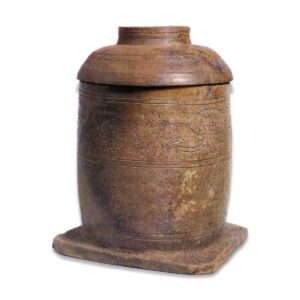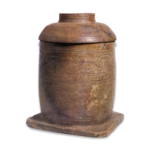
12th century
Total height 33.9 cm (lid) height 8.5 cm, diameter 23.1 cm (body) height 26.6 cm, mouth diameter 21.0 cm, base 25.0 x 25.0 cm
The form and design of this vessel suggest that it may be a sutra tube vessel, but its provenance is not clear. There is another known example exactly like this one. The lid has a low cylindrical strap at the top, and the interior is missing, rendering it useless as a lid. It may have been covered with something on top. The shoulder of the lid is curved with two sunken lines, between which there is a double serrated pattern.
The body is cylindrical in shape with a slightly stretched body, and has a lid holder at the upper end. The bottom has a square base 25 cm on a side and 1 cm thick, and the four corners are cut to create a 3 cm surface. It is a completely unique shape not found in conventional sutra case outer vessels. The body has three parallel sunken lines in the upper, middle, and lower sections, and a series of seven peony petals are depicted in thick carved lines in the space above the body. Four overhead views and three side views of the petals are arranged alternately and connected by a thick stem. In 1973, when the age and provenance of this sutra case outer vessel began to be discussed again, a fragment of a large jar with a peony arabesque design carved between two chinkansen lines was discovered in Higashiyama Kiln No. 105 in the Higashiyama Botanical Garden in Nagoya City, using the same material as this one. This kiln was in the transitional period from ash-glazed ceramics to mountain tea bowls, and dates to the early 12th century. Although the outer vessel has an unusual shape, the fact that the kiln in which it was fired is known is a rare example of its kind.








